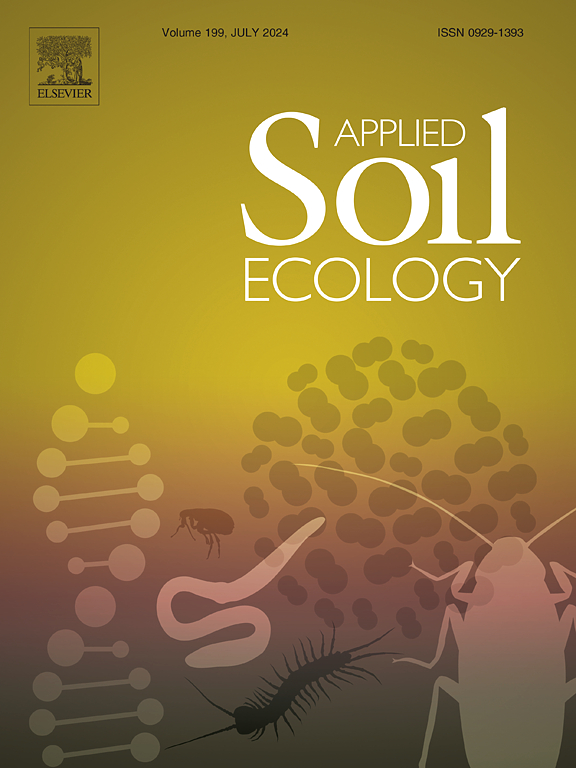Stacking soil health practices is necessary to enhance soil ecosystem multifunctionality of semi-arid almond agroecosystems
IF 4.8
2区 农林科学
Q1 SOIL SCIENCE
引用次数: 0
Abstract
Identifying strategies to rebuild healthy, living soil ecosystems is critical to alleviate widespread soil degradation and enhance the multitude of soil functions fundamental to sustainability, resilience, and agroecological transitions. This is particularly true in California's almond agroecosystems where a combination of semi-arid climates and historical emphasis on aboveground production components has left soils degraded and the most effective strategies to build healthy soil remain unclear. We used a regionally specific survey of commercial orchards to evaluate relationships between adoption of soil health building practices, soil ecosystem functional outcomes, and soil ecosystem multifunctionality. Orchards with applications of single or few principles without orchard redesigns didn't differentiate from bare soils and had the lowest multifunctionally score across the Alley and Tree management zones. In contrast, orchards with stacked application of multiple soil health building practices, such as diverse vegetative understories with animal grazing had the highest soil organic carbon, total nitrogen, soil protein, available P, soil respiration, and robust and diverse soil nematode communities, which resulted in the highest soil multifunctionality score. Results from this study indicate that a diverse and stacked application of soil health principles is the most effective strategy to enhance multiple soil ecosystem functions in perennial semi-arid agroecosystems. It also demonstrates the potential for this approach to uncover the nuanced outcomes of soil health building principles in growers' orchards. As research continues to show the context-specific nature of management's relationships to soil outcomes, this study offers new insights into regional soil health potential and the efficacy of adopting several practices to promote synergistic soil ecosystem functionality in in irrigated semi-arid agroecosystems.
堆垛土壤健康措施是提高半干旱杏仁农业生态系统土壤生态系统多功能性的必要措施
确定重建健康、有活力的土壤生态系统的战略,对于缓解广泛的土壤退化和增强对可持续性、复原力和农业生态转型至关重要的多种土壤功能至关重要。在加州的杏仁农业生态系统中尤其如此,在那里,半干旱的气候和历史上对地上生产成分的强调相结合,导致土壤退化,而建立健康土壤的最有效策略尚不清楚。我们对商业果园进行了一项区域调查,以评估土壤健康建设实践的采用、土壤生态系统功能结果和土壤生态系统多功能性之间的关系。施用单一或少数原则而不进行果园重新设计的果园与裸地没有区别,在小巷和树木管理区的多功能得分最低。不同植生林下加放养的果园土壤有机碳、全氮、土壤蛋白质、速效磷、土壤呼吸最高,土壤线虫群落丰富多样,土壤多功能性评分最高。研究结果表明,在多年生半干旱农业生态系统中,土壤健康原则的多样性和层次性应用是增强土壤多种生态系统功能的最有效策略。它还证明了这种方法的潜力,可以揭示种植者果园土壤健康建设原则的微妙结果。随着研究继续显示管理与土壤结果的具体关系,本研究为区域土壤健康潜力和采用几种做法促进灌溉半干旱农业生态系统中土壤生态系统协同功能的有效性提供了新的见解。
本文章由计算机程序翻译,如有差异,请以英文原文为准。
求助全文
约1分钟内获得全文
求助全文
来源期刊

Applied Soil Ecology
农林科学-土壤科学
CiteScore
9.70
自引率
4.20%
发文量
363
审稿时长
5.3 months
期刊介绍:
Applied Soil Ecology addresses the role of soil organisms and their interactions in relation to: sustainability and productivity, nutrient cycling and other soil processes, the maintenance of soil functions, the impact of human activities on soil ecosystems and bio(techno)logical control of soil-inhabiting pests, diseases and weeds.
 求助内容:
求助内容: 应助结果提醒方式:
应助结果提醒方式:


